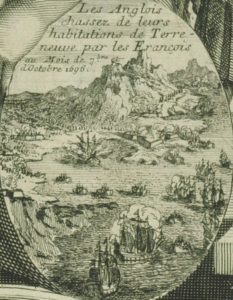Twenty years later, in 1583, Newfoundland became England’s first possession in North America and one of the earliest permanent English colonies in the New World when Sir Humphrey Gilbert claimed it for Elizabeth I. European fishing boats had visited Newfoundland continuously since Cabot’s second voyage in 1498 and seasonal fishing camps had existed for a century prior. Fishing boats originated from Basque, England, France, and Portugal. However, this changed during the initial stages of Anglo-Spanish War, when Bernard Drake led a devastating raid on the Spanish and Portuguese fisheries in 1585. This provided an opportunity to secure the island and led to the appointment of Proprietary Governors to establish colonial settlements on the island from 1610 to 1728. John Guy became governor of the first settlement at Cuper’s Cove. Other settlements included Bristol’s Hope, Renews, New Cambriol, South Falkland and Avalon (which became a province in 1623). The first governor given jurisdiction over all of Newfoundland was Sir David Kirke in 1638.
Explorers quickly realized the waters around Newfoundland had the best fishing in the North Atlantic. By 1620, 300 fishing boats worked the Grand Banks, employing some 10,000 sailors; many continuing to come from the Basque Country, Normandy, or Brittany. They dried and salted cod on the coast and sold it to Spain and Portugal. Heavy investment by Sir George Calvert, 1st Baron Baltimore, in the 1620s in wharves, warehouses, and fishing stations failed to pay off. French raids hurt the business, and the weather was terrible, so he redirected his attention to his other colony in Maryland. After Calvert left, small-scale entrepreneurs such as Sir David Kirke made good use of the facilities. Kirke became the first governor of Newfoundland in 1638. A triangular trade with New England, the West Indies, and Europe gave Newfoundland an important economic role. By the 1670s there were 1,700 permanent residents and another 4,500 in the summer months.
In 1655 France appointed a governor in Plaisance (Placentia), the former Basque fishing settlement, thus starting a formal French colonization period in Newfoundland as well as a period of periodic war and unrest between England and France in the region. The Mi’kmaq, as allies of the French, were amenable to limited French settlement in their midst and fought alongside them against the English. English attacks on Placentia provoked retaliation by New France explorer Pierre Le Moyne d’Iberville who during King William’s War in the 1690s destroyed nearly every English settlement on the island. The entire population of the English colony was either killed, captured for ransom, or sentenced to expulsion to England, with the exception of those who withstood the attack at Carbonear Island and those in the then remote Bonavista.
After France lost political control of the area after the Siege of Port Royal in 1710, the Mí’kmaq engaged in warfare with the British throughout Dummer’s War (1722–1725), King George’s War (1744–1748), Father Le Loutre’s War (1749–1755) and the French and Indian War (1754–1763). The French colonization period lasted until the Treaty of Utrecht of 1713, which ended the War of the Spanish Succession: France ceded to the British its claims to Newfoundland (including its claims to the shores of Hudson Bay) and to the French possessions in Acadia. Afterward, under the supervision of the last French governor, the French population of Plaisance moved to Île Royale (now Cape Breton Island), part of Acadia which remained then under French control.

